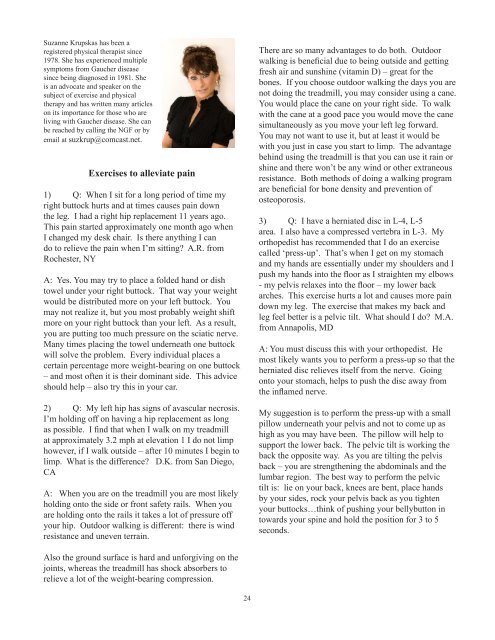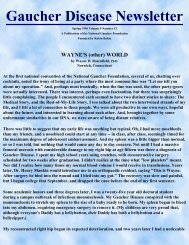Gaucher Community News - National Gaucher Foundation
Gaucher Community News - National Gaucher Foundation
Gaucher Community News - National Gaucher Foundation
Create successful ePaper yourself
Turn your PDF publications into a flip-book with our unique Google optimized e-Paper software.
Suzanne Krupskas has been a<br />
registered physical therapist since<br />
1978. She has experienced multiple<br />
symptoms from <strong>Gaucher</strong> disease<br />
since being diagnosed in 1981. She<br />
is an advocate and speaker on the<br />
subject of exercise and physical<br />
therapy and has written many articles<br />
on its importance for those who are<br />
living with <strong>Gaucher</strong> disease. She can<br />
be reached by calling the NGF or by<br />
email at suzkrup@comcast.net.<br />
Exercises to alleviate pain<br />
1) Q: When I sit for a long period of time my<br />
right buttock hurts and at times causes pain down<br />
the leg. I had a right hip replacement 11 years ago.<br />
This pain started approximately one month ago when<br />
I changed my desk chair. Is there anything I can<br />
do to relieve the pain when I’m sitting A.R. from<br />
Rochester, NY<br />
A: Yes. You may try to place a folded hand or dish<br />
towel under your right buttock. That way your weight<br />
would be distributed more on your left buttock. You<br />
may not realize it, but you most probably weight shift<br />
more on your right buttock than your left. As a result,<br />
you are putting too much pressure on the sciatic nerve.<br />
Many times placing the towel underneath one buttock<br />
will solve the problem. Every individual places a<br />
certain percentage more weight-bearing on one buttock<br />
– and most often it is their dominant side. This advice<br />
should help – also try this in your car.<br />
2) Q: My left hip has signs of avascular necrosis.<br />
I’m holding off on having a hip replacement as long<br />
as possible. I find that when I walk on my treadmill<br />
at approximately 3.2 mph at elevation 1 I do not limp<br />
however, if I walk outside – after 10 minutes I begin to<br />
limp. What is the difference D.K. from San Diego,<br />
CA<br />
A: When you are on the treadmill you are most likely<br />
holding onto the side or front safety rails. When you<br />
are holding onto the rails it takes a lot of pressure off<br />
your hip. Outdoor walking is different: there is wind<br />
resistance and uneven terrain.<br />
There are so many advantages to do both. Outdoor<br />
walking is beneficial due to being outside and getting<br />
fresh air and sunshine (vitamin D) – great for the<br />
bones. If you choose outdoor walking the days you are<br />
not doing the treadmill, you may consider using a cane.<br />
You would place the cane on your right side. To walk<br />
with the cane at a good pace you would move the cane<br />
simultaneously as you move your left leg forward.<br />
You may not want to use it, but at least it would be<br />
with you just in case you start to limp. The advantage<br />
behind using the treadmill is that you can use it rain or<br />
shine and there won’t be any wind or other extraneous<br />
resistance. Both methods of doing a walking program<br />
are beneficial for bone density and prevention of<br />
osteoporosis.<br />
3) Q: I have a herniated disc in L-4, L-5<br />
area. I also have a compressed vertebra in L-3. My<br />
orthopedist has recommended that I do an exercise<br />
called ‘press-up’. That’s when I get on my stomach<br />
and my hands are essentially under my shoulders and I<br />
push my hands into the floor as I straighten my elbows<br />
- my pelvis relaxes into the floor – my lower back<br />
arches. This exercise hurts a lot and causes more pain<br />
down my leg. The exercise that makes my back and<br />
leg feel better is a pelvic tilt. What should I do M.A.<br />
from Annapolis, MD<br />
A: You must discuss this with your orthopedist. He<br />
most likely wants you to perform a press-up so that the<br />
herniated disc relieves itself from the nerve. Going<br />
onto your stomach, helps to push the disc away from<br />
the inflamed nerve.<br />
My suggestion is to perform the press-up with a small<br />
pillow underneath your pelvis and not to come up as<br />
high as you may have been. The pillow will help to<br />
support the lower back. The pelvic tilt is working the<br />
back the opposite way. As you are tilting the pelvis<br />
back – you are strengthening the abdominals and the<br />
lumbar region. The best way to perform the pelvic<br />
tilt is: lie on your back, knees are bent, place hands<br />
by your sides, rock your pelvis back as you tighten<br />
your buttocks…think of pushing your bellybutton in<br />
towards your spine and hold the position for 3 to 5<br />
seconds.<br />
Also the ground surface is hard and unforgiving on the<br />
joints, whereas the treadmill has shock absorbers to<br />
relieve a lot of the weight-bearing compression.<br />
24













